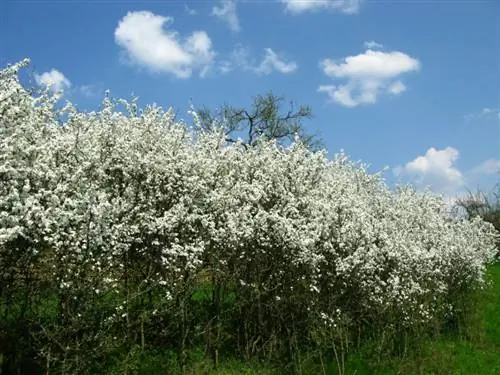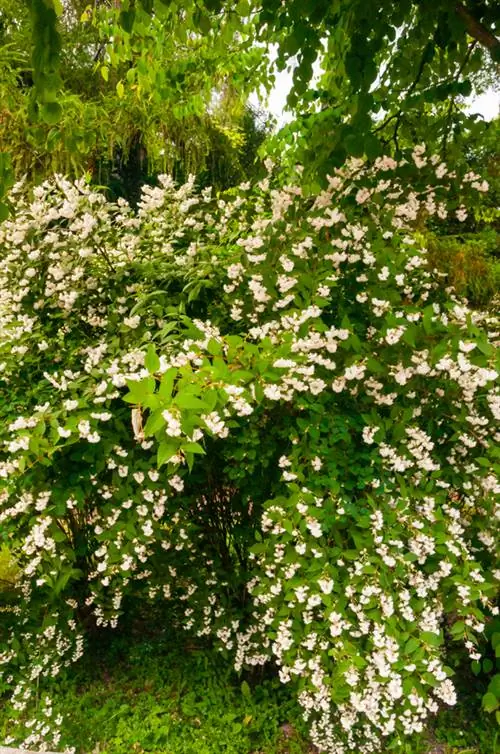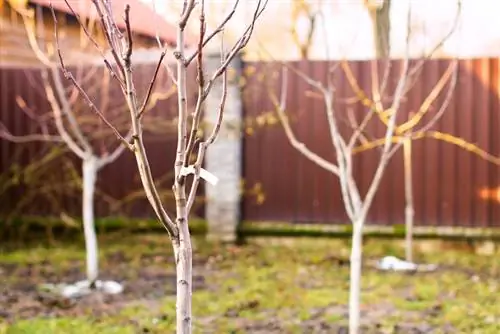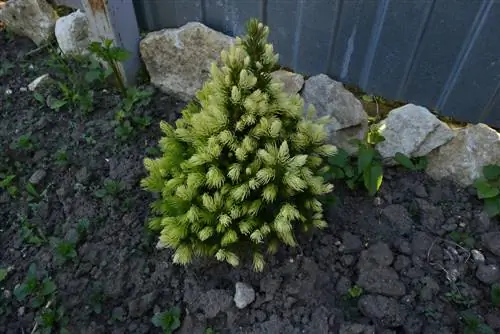- Author admin [email protected].
- Public 2023-12-16 16:46.
- Last modified 2025-01-23 11:21.
Boxwood has been planted in gardens for more than 2000 years. While the evergreen tree was initially used primarily to border flower beds, a new fashion emerged in the course of the 16th century: art gardeners cut the most imaginative figures out of the easy-care plant. Even today the box is still a welcome garden resident, even if its image has been suffering for several years due to dangerous diseases.

How do you plant a boxwood correctly?
Boxwood prefers a sunny to partially shaded location and humus-rich, well-drained soil with a pH value between 7 and 8. The ideal planting time is in autumn or spring. Plant the boxwood with sufficient distance from other plants, water it well and ensure a balanced supply of nutrients.
Which location does the boxwood prefer?
Plant the box in a sunny to partially shaded location, but it should not be too warm. The tree does not tolerate very dark or hot locations. However, it can be full sun as long as you slowly get the plant used to it.
In which soil should you plant boxwood?
Box needs humus-rich, loose and well-drained soil. It doesn't matter whether the soil is sandy or clayey - the important thing is that the pH value is between seven and eight. Solid soils need good drainage to prevent waterlogging.
Which planting time is ideal for boxwood?
Containerware, i.e. H. Boxwoods grown in pots can generally be planted all year round, provided the weather permits. Planting in autumn or spring is ideal when there is no frost or no more frost and the ground has already warmed up a little. Bare-rooted products go into the ground between October and the beginning of May at the latest, while boxwood trees with a developed root ball can be planted until the beginning of June.
What planting distance should you keep?
Boxwood is a shallow-rooted plant that spreads its roots over a wide area and branches, which is why solitary plants need a fairly high distance from neighboring plants. You can only plant the box a little closer together when planting hedges, although the specific planting distance depends on the growth behavior of the selected variety. With weak-growing variants such as the popular 'Blue Heinz', you have to expect around ten plants per meter for an opaque hedge.
What is the best way to plant boxwood?
Before planting, dip the root ball into a bucket filled with water and let it soak for at least half an hour. During this time, dig a planting hole that should be twice the size of the root ball. Mix the excavated soil with compost (€12.00 on Amazon), horn shavings and some rock dust. Place the boxwood in the hole and be careful not to crush the roots. The plant must not be any deeper in the pot than before. Press the soil well and water the newly planted box thoroughly.
Can you transplant boxwood?
In principle, it is possible to transplant a boxwood. But be careful: If a book has been in its location for a long time, such a project will be difficult - it will almost certainly destroy many of the roots. Therefore, it makes sense to prepare well for transplanting. This also includes vigorous pruning of the above-ground parts of the plant, as these cannot be adequately supplied with nutrients and water due to the reduced roots.
How can boxwood be propagated?
The best way to propagate boxwood is through he althy cuttings that are at least ten centimeters long. If you want the plants to be larger, cut offshoots 20 to 30 centimeters long, with cracks rooting more easily and quickly than cut specimens. The best time for vegetative propagation is the months of July and August. Be patient: it takes up to six months for the cuttings to form their first roots.
Can you also cultivate boxwood in a pot?
If the pot is large enough and proper care is provided, boxwood can be wonderfully cultivated as a pot plant. Conventional potting soil, which you can mix with compost and expanded clay, is suitable as a substrate. The pot definitely needs a large drainage hole at the bottom so that excess water can drain away and the box doesn't get its feet wet. Make sure you have a sufficient and balanced supply of water and nutrients; the winter-hardy plant also needs protection from frost and other winter weather hazards in winter.
Is boxwood also suitable as a houseplant?
The boxwood feels most comfortable outdoors, but can also be kept as a houseplant under certain circumstances. The most important thing is that year-round cultivation in the living room is not possible: the boxwood needs a winter rest, which is best spent in a bright but unheated room or another cool room. You should also ventilate frequently and water and fertilize regularly.
Good neighbors / Bad neighbors
Boxwood is a good planting partner for numerous plant species, although when putting them together you should pay particular attention to similar needs in terms of location, soil conditions and care. Bog soil plants such as azaleas and rhododendrons are unlikely to be happy in association with the lime-loving boxwood. However, flowering, tall perennials such as delphiniums, hydrangeas and scabioses form a great contrast to the lush green of the boxwood.
Tip
Boxwood is very susceptible to various diseases and pests. Choose varieties that are as insensitive as possible or, best of all, switch to other, similar species straight away.






